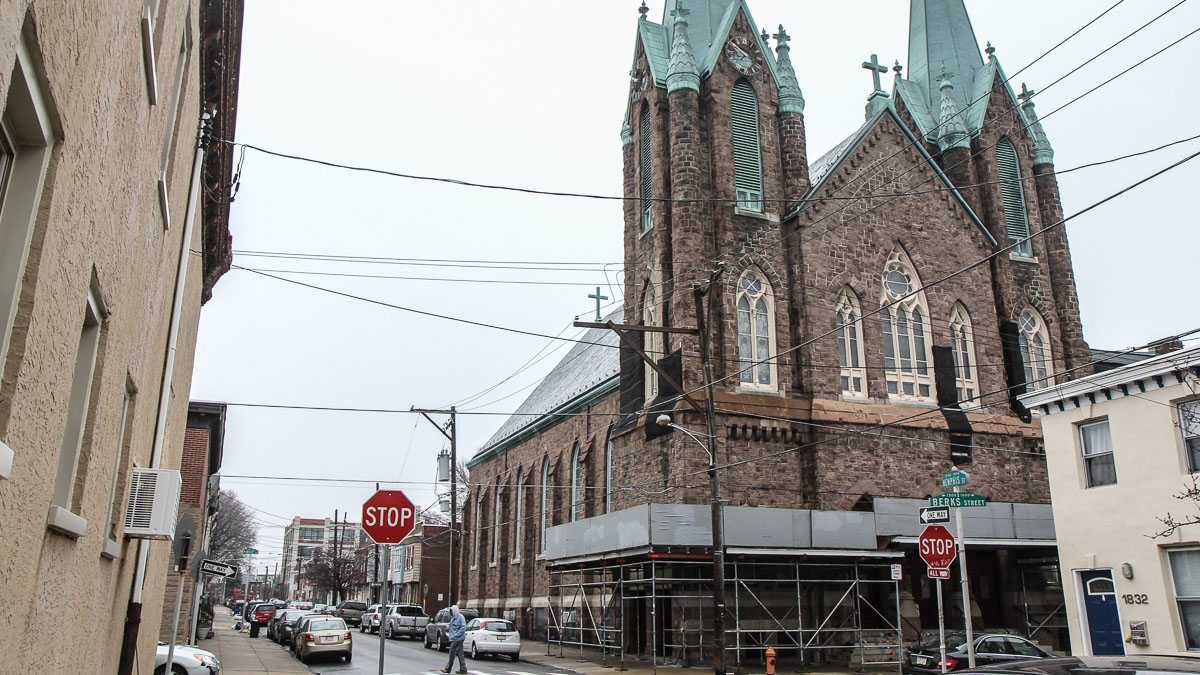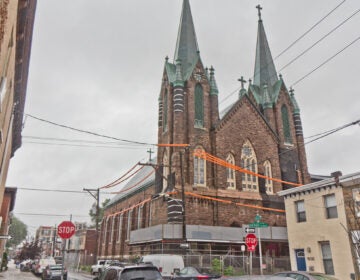Limbo for St. Laurentius as contentious residential plan faces lengthy appeal

Leo Voloshin sounds tired. You can hear it in the Fishtown developer’s voice, as he explains why the fate of St. Laurentius is still up in the air. It’s been more than a year since he conditionally purchased the more than 130-year-old closed Catholic church from Holy Name of Jesus parish, and he’s still at least a year away from beginning construction.
This week the Zoning Board of Adjustment (ZBA) will issue a brief explaining why it gave Voloshin a variance to transform the beloved, but deconsecrated, church into a 23-unit apartment building. The Faithful Laurentians, a tenacious neighborhood group, appealed the board’s decision. Now the case is unlikely to be settled until the end of this year.
“The timeline is just crazy now,” said Voloshin, who offered PlanPhilly an in-depth interview after months of demurrals. “Now it’s a two-year process just to get to the starting line. The fact of the matter is that there is a clock on the building. My gut says that there is only so much time. [The Department of Licenses and Inspections] L&I will let it be a risk, especially in light of the debacle on Market Street.”
Voloshin ticks off the next steps in the process, which he fears will unfold at a grindingly glacial pace. After the ZBA releases the explanation for its variance ruling, opponents of the apartment conversion plan will have a month to establish their standing for challenging the decision. Then Voloshin’s team will submit their brief supporting the ZBA’s conclusion. A hearing could be held as early as July in the Court of Common Pleas, which probably will not decide the case until the end of 2017.
Given the time that’s already passed, Voloshin says that making the necessary structural repairs to St. Laurentius will cost about $1.2 million, a couple hundred thousand more than originally estimated. (The overall budget is about $3 million.) Every freeze-thaw cycle the church goes through will increase the expense. The Department of Licenses & Inspections already declared the building unsafe and placed protecting fencing around it.
From the perspective of the Faithful Laurentians, the neighborhood developer’s plan represents the privatization of an important community and religious space in a rapidly changing neighborhood. Voloshin is the only developer who approached the Archdiocese with a proposal that wouldn’t require demolition of the church, a fate met by many other disused churches, but the Faithful Laurentians dream bigger than preserving the exterior of the building.
“I want the interior preserved and something for the community built,” said Venise Whitaker, one of the leaders of the Faithful Laurentians. “What’s happening to Fishtown is that there is no balance. There is overdevelopment happening and it is taking away the characteristics and identity of the community.”
The controversy over St. Laurentius typifies the battles that rage around the reuse of religious spaces across America. As many Catholic and Protestant congregations continue to shrink, it becomes burdensome for religious organizations to maintain large and often aged churches.
To maintain the finances of the larger institution, churches consolidate or close and leadership deems it necessary to sell hulking surplus structures – putting at risk the distinctive architecture that anchors the identity of many neighborhoods.
Church buildings can be hard to adapt profitably, although creative examples abound locally and nationally. Developers who purchase them are often more interested in demolition to clear the way for new housing, especially in hot real estate markets like Fishtown. According to Voloshin, several other developers he’s spoken with were interested in purchasing St. Laurentius for that very reason.
“It’s a project that barely pencils out,” said Voloshin. “It’s not a lucrative deal. I’m coming at this as a concerned neighbor and citizen because this is the only way forward. ”
At the beginning of last year, Voloshin came to an agreement with Holy Name of Jesus Parish, which St. Laurentius was consolidated into in 2013. Instead of demolishing the building as initially planned–a proposal foreclosed upon when St. Laurentius won historic protection in 2015–they would sell the building to him with the condition that he secure proper zoning for the site.
In September, Voloshin showed the community how he hopes to reuse the church: 23 small apartment units, with space for bike parking in the basement. Being a residential plan, this would seal the building off from the public. (The ZBA granted his variance in mid-November, allowing him to build multi-family units in an area zoned for single family residential.)
Such plans often prove controversial, says Robert Jaeger, president of Partners for Sacred Places, a Philadelphia-based national nonprofit that focuses on congregations in historic buildings. When churches are turned into condos or apartments beloved communal spaces that parishioners most value must be partitioned off, as Voloshin’s plan requires, while many of the intricate interior details are sacrificed or at least obscured from public view.
“Since the sanctuary is often the most glorious space in a church complex, it’s hard to see that cut up into pieces,” said Jaeger.
Jaeger says that in urban areas like Philadelphia, Boston, and New York housing is the most frequent use for old church buildings. But nationally, outside big cities, community spaces that can preserve the interior are more common: a library, a theater, a historical society headquarters. That’s exactly what the Faithful Laurentians want.
The group would prefer no housing, but pressed on the question of compromise Whitaker says that she would settle for some units if the sanctuary could be preserved.
“If you are going to live in a church, live in what looks like a church,” said Whitaker. “When you have the colors and schemes inside St. Laurentius, taking that out is horrifying.”
Whitaker doesn’t believe Voloshin’s plan is feasible anyway. She claims that a conversion to multi-family would be astronomically expensive, more even than the $3 million the developer expects. She fears that he will begin work, realize it doesn’t pencil out, and leave St. Laurentius wide open to demolition.
Whitaker believes the Faithful Laurentians’ vision of a community space of some kind would be cheaper, as the interior wouldn’t have to be extensively re-tooled. Her group is looking into grants and philanthropic support for such a project. She knows they need to be able to show the Archdiocese that they’ve got the funds if her group can ever hope to be taken seriously by the cash-strapped institution.
“A lot of people have offered to donate money if we get the church back into the community’s hands,” said Whitaker. “At this point I’m not really worried I wouldn’t be able to find the funding. It’s out there. In the past year, we’ve grown a lot, we’ve a lot more people, and got a lot more support.”
But she is worried about the condition of the church. The Department of Licenses & Inspections says there is already large crack in one of the towers. And with every winter that passes, repair becomes harder and more expensive.
The commissioner of L&I, David Perri, says Whitaker is right to fear for St. Laurentius.
“When a building is declared unsafe that should put everyone on high alert,” said Perri. “We have a situation that can rapidly change at any point. That’s something to be taken very seriously.”
Jaeger of Partners for Sacred Places believes that the longer the fight drags on, the more pressure there will be to find a compromise. But as the battle over St. Laurentius rages into its fourth calendar year since it was deconsecrated, the two sides seem worlds apart.
After the last historical commission meeting that concerned St. Laurentius, Voloshin and Whittaker walked away from the press together to converse with each other. Several sources told PlanPhilly that they had hoped for fruitful discussion between the two afterwards. Neither would comment on the record about their subsequent meeting, except to say that no compromise resulted.
“There hasn’t been negotiation, they just want not what we are doing,” sighs Voloshin.
The parish’s lawyer, Michael Phillips, says that his client understands that Voloshin is suffering delays and it has no intention of backing out of their arrangement with him. But everything could change if the condition of the church grows worse.
There’s still plenty of time for that to happen. Construction on the church may not even begin with the conclusion of the ZBA appeal. Even if Voloshin wins the day in the Court of Common Pleas, Whitaker says that the site is deeded to the parishioners of the church and not to the parish itself or the Archdiocese–so she contends a trip to Orphan’s Court would be required as well.
Still, Voloshin says he does not regret taking on a development deal where construction could begin, at earliest, two full years after he agreed to buy the building.
“I really believe that if I hadn’t taken this on it would already not be here today,” said Voloshin. “They were moving to take it down and we were the only ones who came forward with an offer that would preserve the building.”
WHYY is your source for fact-based, in-depth journalism and information. As a nonprofit organization, we rely on financial support from readers like you. Please give today.





